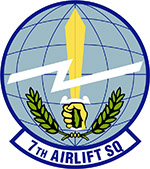
7th Airlift Squadron
Welcome to the 7th Airlift Squadron, supporting America's airlift needs, past and future! No airlift squadron has a longer record of distinguished service to the nation as they continue to live up to their motto: Willing and able.
The 7th AS was McChord's first C-17 squadron and throughout its history, continually accomplished many firsts, including landing the first C-17 on a patch of frozen sea water at McMurdo Station in Antarctica in 1999, and landing the first C-17 in North Korea a few weeks later.